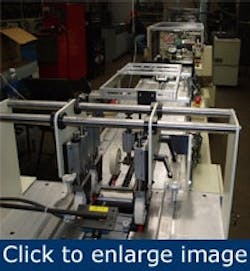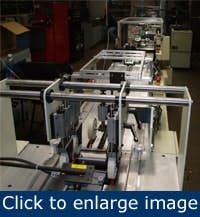On-the-fly motor phasing
Binderies tend to have unique needs in their equipment, but control and maintenance of motors and drives are universal issues that tend to span all industries.
Located in Glen Carbon, Illinois, near St. Louis, Fastechnology Group (Fastech, www.fastechgroup.com) is an industrial control system integration and manufacturing company that specializes in turnkey automation systems. With its core expertise in the commercial printing industry, Fastech often is called upon to make changes in the control architecture and drive mechanics on printing and bindery equipment. The company developed its proprietary Fastpro bindery line control systems, along with application-specific software tools, to streamline the operation and data transmission to and from the bindery floor.
One project involved rebuilding three machines at a binding operation belonging to Arandell (www.arandell.com), a magazine and catalog printer in Menomonee Falls, Wisconsin. A 30-year-old binding system, while still in solid mechanical and framework condition, had worn and obsolete onboard controls. This made it difficult to add needed system functionality while maintaining an integrated control and communication architecture. Arandell turned to Fastech for assistance on the gatherer, binding, conveyor, and trimming stages of its system.
The system required on-the-fly phasing between the motors, which each control a section of the multi-staged conveyor system in the binding operation.
Arandell purchased one used machine and had it rebuilt by Fastech for cost savings, with very satisfactory results, says John Reinert, Arandell vice president of engineering. “We were seeking high performance and safety for our operators, while always keeping our eye on the quality of our finishing operations,” he explains. “The folks at Fastech did all we asked and responded to all our challenges, even a few unexpected ones, along the way.”
The rebuilder implemented some of the goals quickly. An automatic main drive chain lubrication system with a user-settable application interval was needed. Likewise, a marquee for alarm annunciation was needed and installing two 20-character overhead displays enabled a clear view of the machine status from anywhere near the machine. A Siemens Simotion D series processor using the corresponding serial interface module controlled these displays.
The main goal, however, was implementing on-the-fly phasing between the motors on the machine. Each motor controlled a section of the multi-staged conveyor system in the binding operation.
Arandell wanted to be able to adjust handoff points between conveyor sections while the machine was in operation. Likewise, full motion control integration of as many as 10 conveyor sections was needed, as was the elimination of a clutch assembly between two machine sections. Before the retrofit, these two sections were driven by one motor, equipped with a single planetary gear between the sections. This single motor was replaced by two motors and the planetary gear was replaced with an electronic lineshaft, also from Siemens. This modification provided greater control of the product transfer between the two sections, which facilitated a smoother transition over a greater range of machine speeds.
“We evaluated the project and determined our architecture needed to be very flexible, expandable, easy to install, set up and operate for the customer’s plant personnel,” says Dave Carlos, Fastech’s vice president of sales and marketing. “Because so many on-the-fly handling and transition modifications are present in the various magazines and catalogs produced here, we also had the challenge of making the system work at a very cost-effective level.”
[pullquote]The architecture and hardware chosen needed to be reliable and easy to service, he adds. “The Simotion architecture with its integrated motion controller and PLC controller, allowed us to perform advanced motion control along with normal PLC level logic,” explains Jeff Mills, vice president of engineering at Fastech. “The modularity of the line we chose further allowed us to take the functionality we had developed for our customer and apply it elsewhere on similar machine retrofits. Recently, we’ve accomplished rebuilds on four perfect binders, seven saddle stitchers, four stackers, a stand-alone trimmer and mail table, plus numerous machines outside the commercial printing industry, as the result of this platform.”
By updating to this control platform and the on-site training Fastech provided, Arandell realized a 20% improvement in throughput of the overall binding machine operation. Moreover, plant personnel could modify the system after they received the cross-training skills to operate multiple sections of the overall machine.
Fastech updated three machines at the facility, each of which uses the Siemens Sinamics S120 drive and Simotion D drive platform, technology that combines motion control, logic control, and drive control into a single system that became the machine controllers. In tandem with the complementary hardware and HMI, this drive system functions as a common platform/interface for the entire Arandell bindery operation. This enabled operator cross-training to allow for flexibility in crew scheduling.
Furthermore, Arandell could now keep fewer spare parts in stock. And finally, plant communications now run on a single Profibus network.

